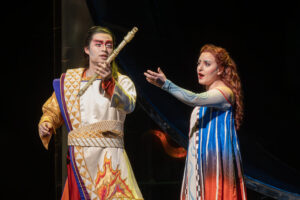

In the narrative, the wealthy medieval troubadour, Jaufré Rudel, has grown weary of his aristocratic life. Consequently, he devotes himself to poetry. His work, in the chivalric mode of the era, praises the reputed qualities of a woman he has never met, a woman he has never seen. Her name is Clémence, and she lives in Tripoli. However, he lives in Aquitane. Which is to say, they have a rather intense long-distance relationship.
This distance constructs the opera’s narrative arc, swinging back and forth from Jaufré’s western sphere to Clémence’s eastern location. When Jaufré finally makes his pilgrimage to Tripoli, to see his muse, his slow migration toward desire becomes a journey into death: Eros and Thanatos merge into one.
The opera, having premiered at the Salzburg Frestival in 2000 to great success, receives its Met debut in a production by Robert Lepage, starring Eric Owens, Tamara Mumford and Susanna Phillips.
Lepage’s direction is enigmatic, engaging, hypnotic, and at times comical. It thrusts one’s nose into the absurdities of love, death, and theology. With a set and costume design by Michael Curry, the most dominant impression is that of the Mediterranean Sea, rolling and swelling, singing, refracting sunlight and starlight, and evoking the untraveled distances between the lover and his object of desire.
Countless LED lights are deployed to create this sea. The effect is a mesmerizing paradox between stasis and movement. The sea rolls and churns, and yet it remains constant in this movement. It’s an image that calls to mind Valery’s “Le cimètier marin” or perhaps Zeno’s paradox—always approaching, and yet never quite arriving. Erotic to the core.

These heady themes require intense and serious performers. As the troubadour, Jaufré, Owens brings a majestic, earthbound presence to the stage. He pours out his love for Clémence, projecting a rich, unwavering sound, anchored and weighty, that is until his fateful pilgrimage to Tripoli.
While Jaufré is rooted to the ground, Clémence’s substance and tessitura are more ethereal and airy—otherworldly, bathed in the transforming waters of fantasy. The singer taking on this role should possess a regal, almost alien quality. And yet, Phillips is all too normal; her voice and looks feel homespun and familiar. She soothes us, when Clémence should surely shock, awe and provoke us. Phillips’ singing is adept enough—she gets through the difficult evening successfully. If only her demeanor and sound were not so vanilla.
As the pilgrim, the intermediary between the two, Tamara Mumford is very satisfying. Her rich, evocative mezzo pulses through Saariaho’s score with measured, expert control. The character possesses a noble, earthy wisdom, traversing the distance between the lover and beloved. She serves as a kind of cupid figure—an intermediary, an advocate, and the source of Eros’ inspiration.
Saariaho’s score, conducted by Susanna Mälkki, is breathtaking. All evocation and sheen, it acts more as an ontology than mere harmony and melody. There is something so wonderfully old and new about this music. It projects the audience out of space and time into unknown contexts; and yet, she manages to simultaneously harken back to the sundrenched coasts of medieval Aquitaine and Tripoli.
At the very end of the opera, Clémence tells us that she is devoting herself to God—a divine object of affection, removed from her, omnipresent, but also terribly intangible. The posture is one of looking into absence, staring into the void. Behind her, the sea and the sky remain forever separated by a swelling, but in escapable, limit: the trenchant horizon.

And it is in this elegant ambivalence where we fully recognize the opera’s thesis: the move from erotic love to theological longing. In the end, Clémence has become the inverse of Jaufré, who once pined for her in a similar act of pagan idolatry, composing verse to her imagined image, desperately working to describe something with no concrete reference point. Much like the mirroring of sky and sea, Clémence mirrors Jaufré in her devotion to God.
In this manner, the opera evokes a queer longing, hinging not on the fruits of sexual or erotic consummation, but on the slow hunger of melancholy. I find this deeply compelling; Saariaho and librettist Amin Maalouf are working with the banal currencies of love and death in provocative ways, teasing out the more transformative aspects of these experiences.
As the opera ends, we wait with Clémence at the limit of sky and sea, staring into the horizon. In her book Eros, the Bittersweet, Anne Carson explains how the ancient world understood erotic love as the experience of limits and failed transcendence. She writes:
Eros is an issue of boundaries. He exists because certain boundaries do. In the interval between reach and grasp, between glance and counterglance, between “I love you” and “I love you too” the absent presence of desire comes alive.
With Jaufré gone, Clémence turns to absence and looks for God. I am not certain she finds Him there. But within this gap, the interval between reach and grasp, the presence of desire springs once again into life.
Photo by Ken Howard/Metropolitan Opera.
Our Own JJ‘s reaction to this opera in the Observer is now online.

























Comments